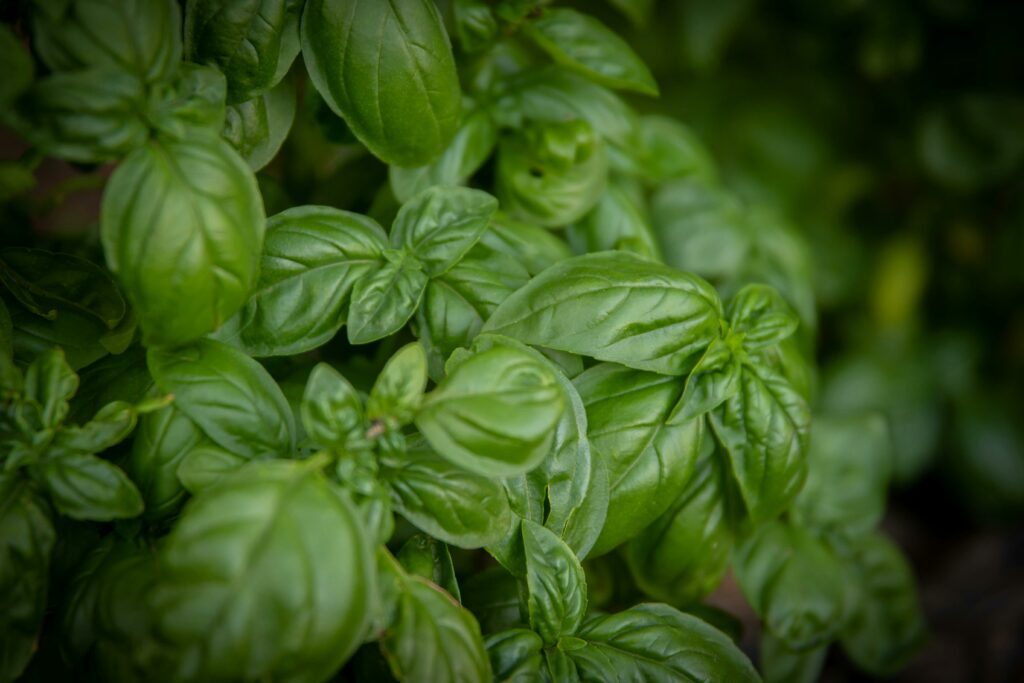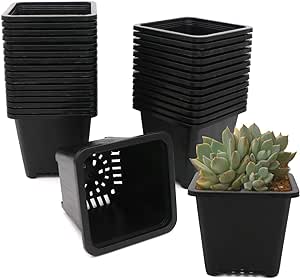Basil, with its vibrant green leaves and distinctive aroma, is a staple herb in kitchens around the world. Whether you’re a seasoned gardener or just starting out, cultivating basil in your own backyard can be a rewarding and delicious experience. Read more to learn just how easy it is to grow basil!
Be sure to buy seeds from a quality supplier. I love Seeds Now. They have a wide range of basil seeds and even some free growing guides!
All About Basil
Botanical Information:
- Botanical Name: Ocimum americanum
- Life Cycle: Herbaceous annual
- Hardiness Zones: All Zones – I start seeds indoors and have a bountiful harvest in zone 3a
- Planting Season: Spring, summer
- Days to Maturity: 60-80 days; can begin harvesting when 6″ tall
Planting Details:
- Depth to Plant Seeds: 1/4″ deep
- Days to Germinate: 5-10 days
- Germination Soil Temperatures: 70°F-75°F
- Spacing Between Plants: 12″-16″ apart
- Spacing Between Rows: 18″-22″ apart
- Number of Plants per Square Foot: 1 or 2 per square foot (I prefer planting them closer)
- Start Seeds Indoors: Yes (Optional)
Soil and Environmental Requirements:
- Soil Types: Sandy, loamy, silty, rich, moist, well-drained
- Soil pH: 6.0-7.5
- Sun Needs: Full sun
- Water Needs: High – keep soil moist
- Heat Tolerant: Yes
- Deer Resistant: Yes
Uses of Basil
Basil is widely used in culinary dishes. Basil is renowned for its aromatic and distinctive flavor profile. Its taste is often described as sweet, slightly peppery, and with hints of anise or clove-like undertones. Depending on the variety, basil can also exhibit subtle differences in flavor intensity and notes, ranging from mild and delicate to bold and robust. Use a dehydrator or hang to dry your basil for use year round!
Basil is not only cherished for its culinary uses but also valued for its potential medicinal benefits. Some of the medicinal properties attributed to basil include:
- Anti-inflammatory: Basil contains compounds like eugenol and rosmarinic acid, which have anti-inflammatory properties. Consuming basil or using basil oil may help reduce inflammation in the body.
- Antioxidant: Basil is rich in antioxidants, such as flavonoids and polyphenols, which help protect cells from oxidative stress caused by free radicals. This antioxidant activity may contribute to overall health and wellness.
- Antimicrobial: Basil has antimicrobial properties that may help fight against certain bacteria, viruses, and fungi. It has been used traditionally to support immune health and combat infections.
- Digestive Aid: Basil has been used in traditional medicine to aid digestion and relieve digestive discomfort. It may help soothe the stomach, reduce gas and bloating, and promote healthy digestion.
- Stress Relief: The aroma of basil has been associated with relaxation and stress relief. In aromatherapy, basil essential oil is used to alleviate tension, promote mental clarity, and uplift the mood.
- Respiratory Support: Basil has expectorant properties that may help loosen mucus and relieve respiratory congestion. It is often used in herbal remedies for coughs, colds, and respiratory infections.
- Blood Sugar Control: Some research suggests that basil may help regulate blood sugar levels and improve insulin sensitivity. Consuming basil regularly as part of a balanced diet may be beneficial for individuals with diabetes or insulin resistance.
While basil offers these potential health benefits, it’s essential to incorporate it as part of a varied and balanced diet, and to consult with a healthcare professional before using it as a treatment for any specific medical condition.
To learn more about medicinal herbs, check out my top 5 medicinal herbs and the remedies to go along with them!

How to Grow Basil With Companions
Basil serves as an excellent companion plant in the garden, offering a myriad of benefits. Its aromatic foliage attracts beneficial insects like hummingbirds, pollinators, and predatory insects that prey on garden pests. Additionally, basil acts as a natural repellent, deterring a wide range of common garden pests including:
- Tomato hornworms
- Aphids
- Asparagus beetles
- Cabbage worms
- Cabbage moths
- Cabbage white butterflies
- Spider mites
- Carrot rust flies
- Flies
- Maggots
Incorporating basil into your garden not only enhances biodiversity but also helps to maintain a balanced ecosystem and reduce the need for chemical pesticides. I love planting my basil in with my tomatoes! Basil can be planted with an array of garden companions:
- Tomatoes: Basil and tomatoes are classic companions in the garden. Basil can enhance the flavor of tomatoes while also helping to repel pests like aphids and hornworms.
- Peppers: Basil is beneficial when planted near peppers as it can improve their flavor and repel pests such as aphids and spider mites.
- Oregano: These two herbs share similar growing conditions and complement each other well in the garden. They can be planted together to create a fragrant and flavorful herb garden.
- Rosemary: Basil and rosemary are both aromatic herbs that can be grown together to create a visually appealing and aromatic garden space. Rosemary’s strong scent may also help deter pests.
- Lettuce: Basil can be planted alongside lettuce to help repel pests like slugs and aphids while also providing a flavorful addition to salads.
- Beans: Basil can help improve the flavor of beans and deter pests such as beetles and aphids when planted nearby.
- Cucumbers: Basil can enhance the flavor of cucumbers and help repel pests like whiteflies and aphids.
- Marigolds: While not a vegetable or herb, marigolds are often planted as companion plants with basil. Marigolds can help repel pests like nematodes and aphids while also adding color to the garden.
How to Plant Basil
Basil is an annual so it’s planted in the spring and will die back likely after the first fall frost. Basil loves heat so ensure temperatures are sufficient before you plant outside. If you live in a zone that has a longer summer, sowing seeds directly into the ground is likely what you’ll do. But, for those of us that live in shorter, cooler zones… we’ll need to start the seeds indoors and transplant to the garden in the spring. Plant the seeds – either outdoors or in a seedling nursery pot – 1/4 inch deep and keep it well watered, but not soggy. Ensure the pots are in a warm area if you plan to start indoors. Once your basil has popped out of the ground and is growing – it’ll need 6-8 hours of sunlight. Make sure the outdoor spot chosen for your basil is full sun and they are spaced 12 inches apart. Ensure your basil gets watered frequently.
How to Harvest Basil
When learning how to grow basil, it’s essential to maintain its growth by promptly removing any flowers that begin to pop out of the top of the plant. This action redirects the plant’s energy towards leaf production and promotes branching. Once your basil plant reaches around 6 inches in height, you can start pinching off the top portions of these branches to further encourage branching. You can bring in the parts you pinched off and use them as you wish. Plus, pinching off will encourage a bushier, healthier plant.
Let me know your basil success stories in the comments! Happy Gardening!







